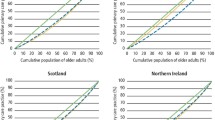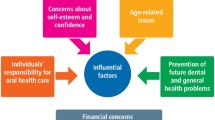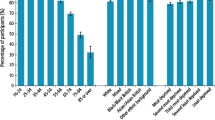Abstract
Aim To model the inequalities in availability of National Health Service general dental practitioners in England and Wales in relation to key socio-demographic factors.
Methods Current estimates of the numbers of NHS general dental practitioners for each health authority were related to data from the 1991 census using Poisson regression models, and generalised estimating equations to allow for correlation between results for neighbouring health authorities.
Results An 'average' health authority, without a dental school, would be expected to have 2,138 residents for every NHS dentist. Controlling for relevant factors, health authorities with higher proportions of the following are associated with lower (better) population to dentist ratios by the amounts shown: each 1% higher female population (–11.8%; 95%CI –19.1%, –3.9% P = 0.004); each 1% greater South Asian population (–1.4%; 95%CI –2.1%, –0.7% P <0.001). A health authority with a dental school is associated with a more favourable ratio compared with one without such a facility (–9.2%; 95%CI –16.2%, –1.6% P = 0.019). Each additional 1% of the following are associated with a worse ratio by the amounts shown: children aged 0 to 14 years old (+5.2%; 95% CI +2.4%, +8.1% P < 0.001); adults aged over 65 years old (+2.8%, 95%CI +1.0%, +4.7% P =0.002); households without a car (+0.8%; 95%CI 0.0%, +1.6% P =0.042).
Conclusions Ensuring access to dental care may be a more complex issue than simply providing adequate numbers of dentists at a national level. Any manpower planning exercise should additionally consider local factors that may act as incentives or disincentives to those professionals who provide care.
Similar content being viewed by others
Log in or create a free account to read this content
Gain free access to this article, as well as selected content from this journal and more on nature.com
or
References
General Dental Council. The Dentists Register. London 1999. Available online at: www.gdc-uk.org/register.
British Dental Association. Dental facts and figures. London 1999. Available online at: www.bda-dentistry.org.uk/public/figures.
Eaton K A, Widstoem E A, Renson C E . Changes in the numbers of dentists and dental caries levels in 12-year-olds in the countries of the European Union and economic area. J R Soc Health 1998; 118: 40–48.
British Dental Association. Manifesto for dentistry. London. July, 1996.
General Dental Council. Professions Complementary to Dentistry. London May, 1999.
Cook P J, Walker R O . The geographical distribution of dental care in the United Kingdom: Part 1 – Sources of information, methods of presentation, distribution of dentists. Br Dent J 1967; 122: 441–447.
Cook P J, Walker R O . The geographical distribution of dental care in the United Kingdom: Part 2 – Changes between 1952 and 1962. Br Dent J 1967; 122: 494–499.
Cook P J, Walker R O . The geographical distribution of dental care in the United Kingdom: Part 3 - Regional synthesis and discussion. Br Dent J 1967; 122: 451–459.
Scarrott D M . Changes in the regional distribution of general dental service manpower. Br Dent J 1978; 144: 359–63.
Buck D . Dental health, population size and the distribution of general dental practitioners in England. Commun Dent Health 1999; 16: 149–153.
Watt R, Sheiham A . Inequalities in oral health: a review of the evidence and recommendations for action. Br Dent J 1999; 187: 6–12.
Chairman, Sir Donald Acheson . Independent Inquiry into Inequalities in Health. London: Stationary Office, 1998.
Eddie S, Davies J A . The effect of social class on attendance frequency and dental treatment received in the General Dental Service in Scotland. Br Dent J 1985; 159: 370–372.
Pavi E, Kay E J, Stephen K W . The effect of social and personal factors on the utilisation of dental services in Glasgow, Scotland. Community Dent Health 1995; 12: 208–215.
National Consumer Council. Consumer Concerns 1998 – A consumer view of health services, the report of an RSL survey. London: September 1998.
Dental Practice Board. Registrations – GDS Quarterly Statistics. January – March 1999 England and Wales. June 1999. Available online at: www.dentanet.org.uk/dental.data.
Petersen P E, Holst D . Utilization of dental health services. In Cohen L K, Gift H C (eds) Disease Prevention and Oral Health Promotion. pp341–386. Copenhagen: Munksgaard, 1995.
Taylor G O, Holloway P J, Lennon M A . A factor influencing dentists' choice of practice location. Br Dent J 1976; 141: 154–156.
ARCINFO . Environmental Systems Research Institute Incorporated. 1996.
Burton P, Gurrin L, Sly P . Extending the simple linear regression model to account for correlated responses: an introduction to generalised estimating equations and multi-level mixed modelling. Stat Med 1998; 17: 1261–1291.
STATA version 5. STATA Corporation. Texas 1995.
Fyffe H E, Pitts N B . Origin, training and subsequent practice location of Scotland's General and Community dentists. Community Dent Oral Epidemiol 1989; 17: 325–329.
O'Brien K D, Roberts C . An analysis of the effects of place of childhood, undergraduate and postgraduate education upon the regional distribution of specialist orthodontic practitioners. Br Dent J 1991; 171: 280–282.
Baldwin P J, Dodd M, Rennie J S . Young dentists – work, wealth, health and happiness. Br Dent J 1999; 186: 30–36.
Croucher R, Osborne D, Marcenes W, Sheiham A . Burnout and issues of the work environment reported by general dental practitioners in the United Kingdom. Community Dent Health 1998; 15: 40–43.
Jones C, Taylor G, Woods K, Whittle G, Evans D, Young P . Jarman underprivileged area scores, tooth decay and the effect of water fluoridation. Community Dent Health 1997; 14: 156–160.
Bedi R, Gilthorpe M S . Ethnic and gender variations in university applicants to United Kingdom medical and dental schools. Br Dent J 2000; 189: 212–215.
Department of Health and Social Security. Towards better dental health - guidelines for the future. Report of the Dental Strategy Review Group. London: HMSO, 1981.
Acknowledgements
The authors wish to acknowledge the kind assistance of Professor Michael Kenward and Dr Mona Abdalla, Medical Statistics Unit, London School of Hygiene and Tropical Medicine. This research arose following a suggestion by Professor Raman Bedi, Eastman Dental Institute. Dr Moles was part funded by a Medical Research Council Advanced Course Studentship. The source of the demographic data used in this study is: the 1991 Census, Crown Copyright. ESRC purchase.
Author information
Authors and Affiliations
Corresponding author
Additional information
Refereed paper
Rights and permissions
About this article
Cite this article
Moles, D., Frost, C. & Grundy, C. Inequalities in availability of National Health Service general dental practitioners in England and Wales. Br Dent J 190, 548–553 (2001). https://doi.org/10.1038/sj.bdj.4801032
Received:
Accepted:
Published:
Issue date:
DOI: https://doi.org/10.1038/sj.bdj.4801032
This article is cited by
-
Are NHS dental practices socioeconomically distributed in Scotland, Wales and Northern Ireland?
British Dental Journal (2020)
-
A rapid review of barriers to oral healthcare for people with protected characteristics
British Dental Journal (2020)
-
A life threatening event from poorly managed dental pain – a case report
British Dental Journal (2007)
-
Alarming increase in dental sepsis
British Dental Journal (2006)
-
A dental workforce review for a Midlands Strategic Health Authority
British Dental Journal (2006)



